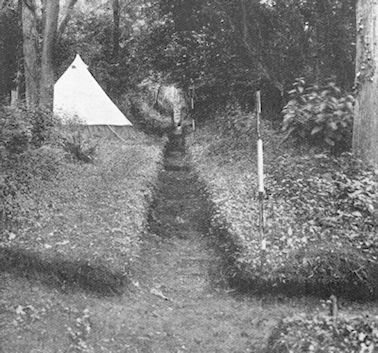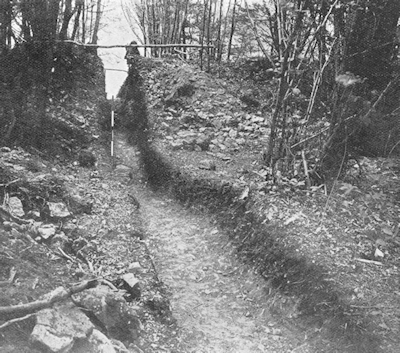

For many, it seems that the decades following Gardner's time at Dinorben (and for some even up to the 1960s and beyond) demanded little fundamental change in strategies for excavating on hillforts, usually involving multiple, narrow trenching of banks and ditches, aiming to sketch out a constructional sequence, and often coupling this with an even less appropriate, highly selective, sampling of the interior. The thoughts of many excavators were evidently still too much concerned with garnering collections of artefacts, which, if there to be found at all, ought anyway to accumulate as a matter of course during excavation devised primarily to probe other aspects of the hillfort in question. It would be tedious to rehearse numerous examples across Wales, and, once more, it must be enough to single out an instance or two, this time in the south-east, giving a flavour of how both subject and discipline were really not progressing in the minds of some senior archaeologists.


Extreme cases can sometimes be most telling, and it seems from a present-day standpoint that Nash-Williams's approach to Llanmelin Camp in 1930-2, which he acknowledged to be 'limited in scope', represents something of a low point, because he took a penchant for narrow trenches to excess (1933 — at the time, this publication was perhaps most welcome for its annexed mapping and listing of hillforts throughout Wales and the Marches). Not only did he pierce the full span of the multivallate earthworks in several places with trenches less than 1m in width, but he even extended these 'through the length and breadth of the camp and the annexe' (Figure 8), disturbing over 200m² of the internal area in the process (and it seems this may be an underestimate of the disturbance done — Williams 2006, 65, fig. 38). This was a risible strategy for fulfilling the stated purposes — viz. 'to elucidate the general character of the settlement' besides 'the technique employed in its construction, and the principal phases in its history' (Nash-Williams 1933, 245) — and it left Nash-Williams with no option but to resort to trite generalisations and guesses, including 'the occupants lived no doubt in rude huts' (1933, 290).
In 1934-6, Nash-Williams took to the field again, this time at coastal Sudbrook Camp, where his cuttings through its bigger banks and ditches were necessarily fewer and a little wider (at least at the top) than those at Llanmelin. They were also far neater, as the published photographs tell (and it should be said that the photos reproduced in Figures 8 and 9 do not reveal the worst of the untidiness evident in some others of Llanmelin), though heavy shoring will have further impeded visibility of detail (Nash-Williams 1939, pl. V). Moreover, talk of ill-defined 'hut-floors' in undefined 'trial exploration' does nothing to improve the credibility of such work — only a photograph of intensive trenching, and this principally set out about a rectangular stone building believed medieval (Nash-Williams 1939, pl. VI.2), divulges anything of the character of excavation inside this hillfort, for the published plans do not even outline its extent.14
Internet Archaeology is an open access journal based in the Department of Archaeology, University of York. Except where otherwise noted, content from this work may be used under the terms of the Creative Commons Attribution 3.0 (CC BY) Unported licence, which permits unrestricted use, distribution, and reproduction in any medium, provided that attribution to the author(s), the title of the work, the Internet Archaeology journal and the relevant URL/DOI are given.
Terms and Conditions | Legal Statements | Privacy Policy | Cookies Policy | Citing Internet Archaeology
Internet Archaeology content is preserved for the long term with the Archaeology Data Service. Help sustain and support open access publication by donating to our Open Access Archaeology Fund.